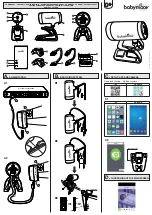
1 - 20
• Digital input signal presence judgment
For digital signals, the input signals are judged as the following table according to the state of
the SCDT signal (64-pin) input into the microcomputer (IC102) from the TMDS receiver
(IC500).
The TMDS output buffer power save signal/PD0 and internal logic power save signal/PD are
controlled as the following table according to the state of the front power switch, display input
signal (Ch) and SCDT signal.
If there is no digital signal input (SCDT = Lo), the display input signal (Ch) is analog (DVI-I (A)
or D-SUB) or the front power switch is OFF, the TMDS receiver's output buffer power is low-
ered (/PD0 = Lo) (excluding the SCDT output) by the /PD0 terminal. Normally, the input signal
presence is judged constantly. However, during the PMS mode, the microcomputer sends the
PWM signal to the /PD terminal (TMDS receiver power down at Lo) to control the power con-
sumption of TMDS receiver, so the power consumption can be reduced according to the On
duty (intermittent control).
(Note: OSM cannot be set for the mass-production F/W. The /PD PWM cycle is fixed to
500msec and to 50msec for the period /PD is Hi.)
The /PD PWM cycle and Hi interval are determined considering the fact that for the power
consumption during power save, the Hi interval rarely drops below 50msec. In addition, the
SCDT software filtering interval, feedback time from power save, time for SCDT to start after
DE is input, and the time to start counting after /PD is turned ON and PLL starts are also
considered.
* Software filtering is used to prevent malfunctioning in the PMS mode, considering the possi-
bility of noise in SCDT signal output of the TMDS receiver.
(Microcomputer input port)
SCDT
Hi
Lo
Results of input signal judgment
of digital signal
Input signal present
No input signal
(Microcomputer
input port)
SCDT
(Microcomputer
output port)
/ PDO
(Microcomputer
output port)
/ PD
(Microcomputer
output port)
P_TMDS
On
On
On
Off
Hi
Lo
Don’t
Care
Don’t
Care
Lo
DVI-I(D)
DVI-I(A)
D-Sub
Don’t
Care
Front power
SW
Display
input signal
(Ch)
Hi
Hi
Hi
FIRST,
LAST DETECT : Hi
NONE : Lo
Lo
Normal : Hi (TMDS receiver On)
During PMS : PWM (TMDS receiver intermittent On)
Normal : Hi (TMDS receiver On)
During PMS : PWM (TMDS receiver
intermittent On)
Normal : Hi (TMDS receiver On)
During PMS : PWM (TMDS receiver
intermittent On)
Lo (TMDS receiver Off)
Hi (TMDS receiver output enable)
Lo (TMDS receiver output open)
Lo (TMDS receiver output open)
Lo (TMDS receiver output open)
Lo (TMDS receiver output open)
Summary of Contents for LCD1550X-BK
Page 88: ...SCHEMATIC DIAGRAM POWER LCD1550X Normal Power Save 1ch Pin 4 2ch Pin 1 3ch Pin 2 4ch Pin 5 ...
Page 89: ...SCHEMATIC DIAGRAM PWB MAIN POWER LCD1550X ...
Page 90: ...SCHEMATIC DIAGRAM PWB MAIN INPUT LCD1550X ...
Page 91: ...SCHEMATIC DIAGRAM PWB MAIN SYNC LCD1550X ...
Page 92: ...SCHEMATIC DIAGRAM PWB MAIN TMDS LCD1550X ...
Page 96: ...SCHEMATIC DIAGRAM PWB MAIN ASIC LCD1550X ...
Page 97: ...SCHEMATIC DIAGRAM INVERTER LCD1550X 1ch Q701 B 2ch Q702 B ...
Page 98: ...SCHEMATIC DIAGRAM PWB SW LCD1550X ...
Page 100: ...SCHEMATIC DIAGRAM POWER LCD1550X ...
Page 101: ...SCHEMATIC DIAGRAM PWB MAIN POWER LCD1550X ...
Page 102: ...SCHEMATIC DIAGRAM PWB MAIN INPUT LCD1550X ...
Page 103: ...SCHEMATIC DIAGRAM PWB MAIN SYNC LCD1550X ...
Page 104: ...SCHEMATIC DIAGRAM PWB MAIN TMDS LCD1550X ...
Page 105: ...SCHEMATIC DIAGRAM PWB MAIN MC LCD1550X ...
Page 106: ...SCHEMATIC DIAGRAM PWB MAIN ASIC LCD1550X ...
Page 107: ...SCHEMATIC DIAGRAM INVERTER LCD1550X ...
Page 108: ...SCHEMATIC DIAGRAM PWB SW LCD1550X ...
Page 155: ......
Page 156: ......
Page 157: ......
Page 158: ......
Page 159: ......
Page 160: ......
Page 161: ......
Page 162: ......
Page 163: ......
Page 164: ......
Page 165: ......
Page 166: ......
Page 167: ......
Page 168: ......
Page 169: ......
Page 170: ......
Page 171: ......
Page 172: ......
Page 173: ......
Page 174: ......
Page 175: ......
Page 176: ......
Page 177: ......
Page 178: ......
Page 179: ......
















































